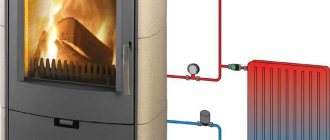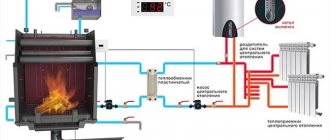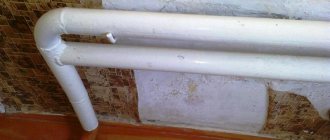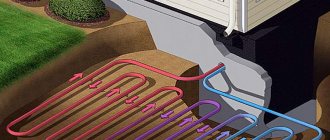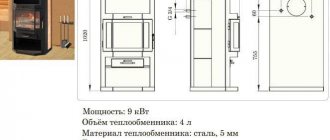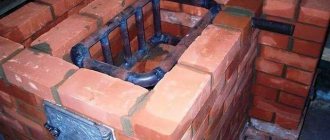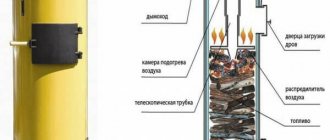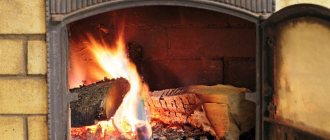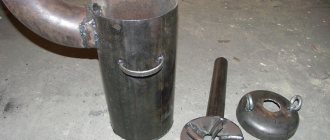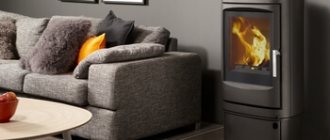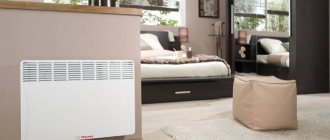An archaic fireplace looks beautiful, but the feasibility of its presence in a modern home raises doubts. I wouldn’t want to spoil the comfort of my home with soot. And the thought of a fire also worries me. It’s common to light a fire while relaxing in nature, but in your room it’s a little scary.
A safe solution would be a fireplace with a water heating circuit.
What is a fireplace with a water circuit
A fireplace is the oldest attribute of the interior of a human home. Since time immemorial, most family events have taken place around the hearth. Now you can buy a fireplace stove with a water heating circuit for the most sophisticated design.
Technological advances have led to a wide variety of designs for this traditional heat source. One of them is an aqua fireplace with the function of heating water circulating through the heating system. Now it can heat not just one room, but the entire house.
Principle of operation
A fireplace with a built-in water circuit works in the same way as a wood-burning stove for heating, which has a heating system heat exchanger built into its design.
Advantages
Installing a fireplace adds sophistication to the design. The room can be quickly warmed up when it gets cold outside or after a long absence from the country house. And the heating system of the entire building will start working immediately.
The benefits of purchasing an aqua fireplace do not end there:
- The fancifully shimmering flames are one of three paintings that you can look at endlessly. Relaxing by the fire is the most ancient, relaxing and soothing.
- The fireplace design does not contain moving mechanisms. There's simply nothing to break there. Durability is ensured by thousands of years of experience in using open fire.
- The aqua fireplace has a double body. Water from the house heating system circulates inside. The metal does not overheat from contact with an open flame, so the service life of the product is measured in decades.
- A traditional fireplace equipped with heat exchangers connected to the building's heating system has a coefficient of performance (COP) of 80%. This is the level of modern heat generators.
- A boiler can be connected to the aqua fireplace to provide the cottage with hot water supply.
- Fire safety is guaranteed by the use of a heat-resistant transparent firebox door. At the same time, the soft infrared spectrum of the flame freely penetrates through the glass, pleasantly warms the owners of the fireplace, and creates a cozy, warm atmosphere.
- Cheap fuel: firewood, coal, fuel briquettes - provides significant annual savings.
- Stove and fireplace heating is completely autonomous, which allows you to build a country house far from gas and electrical networks. The presence of a small-power electric generator makes it possible to use automated pellet feeding of the firebox for long-term continuous combustion.
- Modern aqua fireplaces are quite light. They can be installed without a foundation on a non-combustible base, for example, ceramic tiles.
- The varied designs of modern fireplaces have a common characteristic - compact sizes with a fairly high thermal output, which is important for small rooms.
- There is no inertia inherent in traditional massive furnaces. In a matter of minutes, a flaming flame will warm the room where the aqua fireplace is installed. If a circulation pump is provided, then the entire building is not afraid of sudden changes in outside air temperatures.
- The price of a massive stone fireplace or stove, together with the foundation and chimney, exceeds the cost of an aqua fireplace, the installation of which is quite simple, so it is possible to install it yourself. But it is now difficult to find a professional mason; his services are expensive.
- With a combined heating system, savings of up to 50% of the initial cost of gas equipment are possible. The maximum boiler power is calculated at the minimum winter temperature. At the latitude of Rostov-on-Don it is -24 °C. In practice, frosts rarely fall below -10 °C. When it gets colder, an aqua fireplace will help out. The rest of the time can be saved without sacrificing comfort.
Flaws
Modern people are spoiled by centralized heating of their homes, so even minor additional troubles with a fireplace can be very confusing.
However, there are not many problems:
- In strong winds, reverse draft is possible. Smoke and soot enter the room from the combustion chamber. To avoid such a nuisance, the chimney must rise above the ridge of the roof or be at a certain distance from it. The exact values for a specific case are calculated based on building codes and regulations (SNiP). Installing a deflector will help stabilize and increase traction.
- If a country house is not intended for permanent residence, then in winter the water from the heating system must be drained during absence. Otherwise the pipes will burst. The durability of the building and the safety of the interior will be guaranteed if the internal temperature is maintained at a level not lower than +10 °C. This can be achieved by automated pellet fuel supply or by installing an electric boiler for emergency heating.
- Installing a fireplace is more expensive than connecting an electric boiler. But electricity is one of the most expensive types of fuel. In addition, power outages are not uncommon.
- Regular cleaning of the chimney from soot is required 2 times a year, and more often with intensive use.
How to choose and what to pay attention to?
What qualities must a heating equipment have to become a reliable source of heat?:
- Power . Varies with the size of the firebox and the dimensions of the stove. On average, a room of 10 m² requires 1 kW of power.
- Dimensions . Must fit into the installation room.
- Coolant volume . It consists of the volume of pipes and radiators, depending on the total length of the system and the number of batteries. Another 10% is added to the resulting value.
- Chimney cross section . The indicator is important for selecting suitable structural elements.
- Additional options . Cooking and heating food, easy glass cleaning, non-heating handles and other easy-to-use little things.
What does it consist of?
The design is extremely simple: body, firebox, heat exchanger. The housing can be free-standing. It is sometimes embedded in a solid wall or a decorative frame made of brick, forged or stone sculptures. The firebox is steel, but the grates are usually cast iron. Welded heat exchanger made of seamless pipes. An air duct is connected to the bottom of the firebox, and a chimney is connected to the top.
Frame
The metal casing of the aqua fireplace is hollow inside. Water circulates between the outer and inner walls. This is where its heating begins, and then it enters the upper register of the heat exchanger. As a result of this technical solution, the outer shell cannot even theoretically heat up above 100 °C, therefore it is completely fireproof.
A hob is sometimes placed on the upper plane. This design is relevant for small country houses, where the kitchen, dining room and living room are combined in one room.
The geometry of the case depends only on the designer’s imagination. The main thing is that the combustion chamber fits in it.
The combustion chamber
Conventional fireplaces had a low efficiency of 20% due to imperfect heat extraction during fuel combustion. The room was heated by the infrared radiation of the flame. There was a large portal in front so that the rays from the fire could warm the maximum area of the room.
Additionally, a small amount of heat warmed the air in the house due to convective heat transfer from the hot body. The remaining 80% of the heat escaped through the chimney along with combustion products - hot gases.
The design of aqua fireplaces provides for the possibility of changing the fuel burning rate by regulating the flow of supply air into the lower part of the firebox. The portal is closed with heat-resistant glass. It blocks uncontrolled access of air to the fire, which makes the aqua fireplace fireproof.
To reduce the likelihood of drafts, provide for the flow of air into the firebox through a pipe. A fine grill to keep rodents and cats away is installed outside. There is an adjustable damper in front of the fireplace.
On top of the portal there is a “clean glass” system - a longitudinal slot with guides for a small amount of fresh air from the room. A stream of cold air “flows” along the inside of the glass, preventing soot contamination.
Heat exchanger (water heating circuit)
In the upper part of the firebox there is a register of pipes for collecting heat from hot gases. The coolant, water, flows inside the pipes. If the power of the aqua fireplace is very high, then additional registers are placed along the side and rear walls of the firebox. To improve heat transfer and increase efficiency, there must be a circulation pump. As a result, the efficiency of the aqua fireplace increases to 80%.
When heated, water increases its volume, so it is necessary to install an expansion tank. With an open heating system, it is installed at the highest point - usually in the attic. When closed, the membrane-type tank is mounted in any place convenient for maintenance. A pressure gauge and a safety valve are mounted nearby.
Chimney
Ceramics or metal are used to remove gaseous combustion products. Ceramic chimneys are durable, but expensive and labor-intensive to install.
The smoke channel pipe is glazed during manufacture. This prevents soot from sticking and makes cleaning easier. It is separated from the chimney body by heat-resistant thermal insulation. At the bottom there is a container for collecting condensate.
Main characteristics of ceramic chimneys:
- service life - over 25 years;
- glassy surface prevents soot deposition;
- fireproof;
- do not burn out;
- a significant mass must rest on the foundation;
- high cost of components;
- complex installation.
Metal chimneys are much cheaper and easier to assemble. If the operating mode is violated, they may burn out.
Steel pipes are assembled using a sandwich design. The inner pipe made of technical stainless steel is separated from the outer one by fiber-basalt thermal insulation. Individual blocks are joined using heat-resistant sealant.
Characteristics of metal chimneys:
- the cost of purchase and installation is less than that of ceramics;
- it is possible to assemble it yourself;
- light weight, so no foundation is needed;
- Do not allow the flame to break through into the chimney.
Heating system components
Most often, water heating systems are used for residential buildings. This approach to solving the problem is traditional. It has one undeniable advantage - its versatility. Heat passes to all corners of the room due to the special property of the coolant. It can be heated using various energy sources. Also, the water system allows you to arrange combined types of heating, when there are several energy carriers, and they all differ in properties. Any heating system can be divided into the following components:
- heat source;
- pipe network with fittings and additional equipment;
- heating radiators and heated floors.
To regulate the operation of the coolant, shut-off and control valves and additional equipment are used. The latter combines the following elements:
- circulation pump;
- hydraulic arrow;
- expansion tank;
- distribution manifold;
- buffer capacity;
- tools and instruments necessary for automation;
- indirect heating boiler.
Additional volumes of water can create a certain amount of pressure on the joint area if it is in a confined space. To avoid this situation, an expansion tank is installed in the network. She takes on all the excess water. There are membrane and open type containers.
An indirect heating boiler is a special tank equipped with a coil. Heating of water for domestic needs is carried out here directly from the coolant. To monitor water pressure and temperature, a pressure gauge is installed. Control over the coolant indicators is carried out using automated means, controllers and sensors.
Types of fireplaces
Wood-burning stove-fireplace
This modification arose as a result of a natural desire to replace a conventional wood-burning stove in a country house with an aesthetic fireplace. To do this, it was necessary to increase its efficiency.
The problem was solved by three design improvements:
- The air flow into the firebox is not through the open frontal plane, but through the grates from below. The intensity of fuel combustion is regulated by the position of the gate in the ash pit.
- The portal is closed with transparent heat-resistant glass. Infrared rays pass through it freely, heating the entire room.
- A heat exchanger is installed on top of the firebox.
Pellet fireplace
An alternative option was developed after the invention of pellets - granulated fuel from peat, organic waste from the woodworking industry, and agriculture. Standardization of the size of the new type of biofuel made it possible to automate the combustion process as much as possible.
The frequency of servicing the aqua fireplace has changed from several hours to a month. Ignition, control, and regulation of the process are carried out by a built-in controller.
The design of any pellet stove consists of several systems:
- Storage facility with gravity fuel supply system. As the granules are consumed, they fall down the inclined surface to which the vibration mechanism is connected.
- Fuel line with vacuum pump or screw doser.
- Built-in fireplace receiving hopper.
- Combustion chamber with flame control.
- Periodic cleaning of the chimney and ash chamber using spring mechanisms.
As the pellets burn out, fuel is supplied from the built-in hopper. The intensity of the supply of granules is automatically adjusted depending on the set room temperature and changes in weather conditions.
When the bunker is empty, the supply of biofuel is periodically switched on through a fuel line from the storage facility, the dimensions of which determine the duration of operation of the entire system without rebooting.
Fuel requirements
Hornbeam, oak, birch or aspen logs are ideal for lighting the stove. When burning, they emit less soot and smoke.
You should not buy coniferous wood, cherry, willow and elm. They are characterized by a large amount of resin and soot. Logs can produce sparks, which increases the risk of fire and negative impact on human health.
Firewood should be lit with birch bark, wood chips, paper products or a special liquid. It is imperative to ensure that during the process the gate valve is open all the way and that there is sufficient aeration in the ash pit.
By the way, the usual wood-burning stoves-fireplaces are far from the only type. For some time now, they have been in no way inferior in popularity to gas, electric analogues and those that run on special biofuel.
Types of fireplaces by material of manufacture
To construct aqua fireplaces, brick, natural stone, ceramics, cast iron, steel sheet, basalt fiber insulation, and heat-resistant glass are used.
Brick
The fireplace stove can be custom-designed to almost any configuration. Finishing with tiles will emphasize the individuality of the interior. As a rule, high-quality working bricks (refractory) are used in such fireplaces.
Requires careful adherence to technology and high-quality installation. Installed on a separate foundation. The high starting cost is justified by the increased comfort.
Metal
The most profitable due to the optimal price/quality ratio. Light weight, affordable price, simple installation, and varied designs contribute to their widespread distribution.
Combined
They combine the comfort of infrared fireplace heating, the heat capacity of a massive stove, and the functionality of a water heating system. They have the highest possible efficiency. They release accumulated heat for a long time after the fire goes out.
A combustion chamber with a heat exchanger is built in during the construction of a brick or stone fireplace facade. Since access for repairs will be difficult later, the cast iron option is optimal. A separate foundation is required, so it is recommended to use a durable ceramic chimney.
Payment for the order
1. Payment in cash to the courier upon delivery of the goods (only for residents of Moscow and the Moscow region) or at the pick-up point.
2. Payment by bank transfer to the organization's current account according to a pre-issued invoice. The price for some products may be changed for this type of payment.
3. Payment by credit card upon delivery of goods (only for residents of Moscow and the Moscow region). It is necessary to warn the manager about this payment method when placing an order.
4. Payment by credit card from the site. When placing an order, notify the manager that you want to pay from the site. The price for some products may be changed for this type of payment.
5. Payment by electronic money.
6. Payment through terminals.
If you have chosen to pay in cash to the courier or by credit card upon delivery of the goods, then you can pay for the purchase directly with the courier of our store at the time of delivery of the order. Payment is accepted only in Russian rubles upon delivery of goods and transfer of all necessary documents. This payment method is only available to individuals.
For individuals living outside the Moscow region and receiving goods through a transport company, as well as for legal entities, payment is made in cashless form to the store’s bank account. In this case, payment for the order is made according to the issued invoice, which you can receive at the fax number or email address you specified.
Criterias of choice
When choosing, most buyers are guided by cost and their own taste, paying attention only to the appearance of the product.
It is also advisable to take into account other factors:
- thermal power;
- durability;
- burning duration of a disposable fuel filler.
Power is determined depending on the size of the house area and the minimum outdoor temperature in winter. The manufacturer indicates the corresponding characteristics in the product passport. If they are not there or the numbers are very approximate, then you can use the calculation method from SNiP.
Then you need to consider:
- climatic conditions in the place of residence;
- design characteristics of premises;
- size of heated area;
- number of external walls;
- orientation of the external walls according to the cardinal directions - south, east, west, north;
- thermal resistance of external walls, depending on the thickness and thermal conductivity of the material;
- outside air temperature during the coldest week of winter;
- ceiling height;
- what is below/above: a heated or cold room, an attic - insulated or not;
- degree of floor insulation;
- presence of a basement;
- number/size of windows;
- window design: wood or metal-plastic, double or triple glazing, argon filling;
- presence/size of doors to the street or balcony.
Each room must be counted separately. Then sum up the heat loss - this is the maximum power of the heat-generating unit, which will still need to be increased by a safety factor of 15-20%.
Finishing work
The finished structure can be finished with finishing material. There is a wide variety of different materials, but stone and marble are used most often. These materials can give the interior a luxurious look.
In addition to natural stone and wood, you can use simple plaster, which will cost several times less.
The plaster can match the shade of the floor. There is an option not to decorate the fireplace at all; it will look beautiful on its own.
Popular models and their costs
Angara Aqua
Power 16 kW, dimensions 104 x 70 x 45 cm, weight 205 kg, cost from 32,000 rubles.
A characteristic feature is the convection grille in the upper part. Designed for accelerated heating of ambient air.
Prices for the Angara Aqua fireplace model
hangara aqua
Pechora Aqua
Power 18 kW, dimensions 104 x 75 x 49 cm, from 40,000 rubles.
The firebox is lined from the inside with a refractory lining. The prismatic side walls are decorated with ceramics. The convection niche is enlarged and can be used to heat food instead of a microwave.
Prices for the Pechora Aqua fireplace model
pechora aqua
MBS Thermo Vesta plus
Power 11 kW, dimensions 89 x 46 x 44 cm, 42,650 rub.
A diverse range of models is achieved by the capabilities of high-quality cast iron casting of component parts. The decent-sized upper platform allows you to boil a kettle or even prepare a simple dish. In this case, there is no heat exchanger.
Prices for the MBS Thermo Vesta plus fireplace model
MBS Thermo Vesta plus
EcoFireplace Alsace
Power 11 kW, made in Germany, dimensions 97 x 145 x 49 cm, RUB 189,900.
The external beauty and versatility of using tiles for external cladding are captivating. But it is completely unclear how the declared 80% efficiency is achieved. There are no water heat exchangers.
EcoFireplace Bavaria with stove and heat exchanger
Power 11 kW, dimensions 945 x 710 x 540 mm, RUB 47,200.
Increasing the volume of the firebox in width made it possible to obtain increased thermal power. This created enough space for the location of the cooking zones. A convenient option for small country houses with a combined kitchen-dining room. The prismatic glass facade heats almost the entire room.
MBS VULKAN
Power 17 kW, dimensions 85 x 48 x 60 cm, 66,440 rub.
A powerful, squat stove, solid and reliable.
La Nordica Termo Cucinotta
Power 9.1 kW, dimensions 68 x 86 x 65 cm, from RUB 178,400.
Italians are recognized trendsetters not only in clothing and shoes. Some fireplace models are worthy of installation in a royal palace. The advertised system of “tertiary combustion” of fuel may raise doubts among a professional boilermaker. At the same time, the declared efficiency of 78.8% is quite realistic in the presence of a water heat exchanger.
Specifications
European manufacturers of fireboxes with a water circuit manufacture them according to the German DIN+ standard. In Russia, it is necessary to take into account not only these standards, which determine the technical characteristics of stoves, but also heating standards. It is better to understand the features of fireplace production and their capabilities using the example of Spartherm Varia 1V H2OXL. The dimensions of the stove are exactly the same as they would be if it did not have a heat exchanger: width - 75 cm, height - 123 cm, depth - 55 cm.
To calculate the compliance of the technical characteristics of the stove with heating needs, a house with a total area of 160 square meters was selected as an example. meters. According to Russian heating standards, at a temperature outside the window of -27 degrees Celsius, spend 1 square meter on heating. meters you need no more than 50 W every hour. The rated power of this firebox is 14 kW, of which 10 kW is provided by the heat exchanger, 4 kW by thermal radiation. There are two glasses in the firebox door: the inner one has a film that reflects heat, so as not to overheat the building and not burn the skin when touched; the outer one is decorative.
The calculation period is 5 days, during which the stove will heat the house all day. In 12 hours, the fireplace produces 14 kW hourly, of which 8 kW is spent on the heating needs of the house (radiators, etc.). 1 kW is spent on heating water for domestic use. The boiler accumulates the remaining 5 kW every hour. On average, throughout the day it can accumulate about 60 kW, which will be used to heat the house at night. To accumulate such an amount of heat, the storage boiler must have a volume of at least 700 liters.
How it works - video guide
DIY making
Construction of a fireplace without relevant experience is possible if you have detailed drawings indicating the order of laying bricks. First, a concrete foundation is poured or it is laid out from blocks to the level of the subfloor. Waterproofing from roofing felt is installed on top.
It is advisable to use fireclay products for the firebox. The heat exchanger is preferably made of cast iron, but a welded pipe register with a wall thickness of at least 4 mm is suitable. The connections of the heat exchanger with the heating pipes must be located outside the firebox.
The rest is built from refractory bricks with clay mortar. After forming the vault, a chimney is mounted on top. It can be built without pipes from bricks at the back of the fireplace on its own foundation.
Before igniting after completion of construction, you must wait two weeks. Then fill the system with water. Carry out the first fire in a gentle mode, gradually increasing the flame.
Delivery to regions
We can deliver your order to any region and city in Russia. The cost of delivery depends on the distance between cities, weight, volume of the goods and is calculated when ordering the goods. On the page of each product in the delivery section, you can specify the city and find out the cost and delivery time of the product. You can write to the delivery service at the address, indicating the product you are interested in, the exact delivery address (pickup warehouse or your address) and the delivery service will calculate the cost of shipping the goods. You can also get advice by phone: 8 (495) 926-26-22. Payment for goods in case of delivery to the region is made by bank transfer with 100% prepayment or by card through the website, or can be paid by your representative in Moscow in cash. All necessary documents are transferred along with the goods or to your representative.
The delivery time depends on the distance and the product and ranges from 2 days to the nearest regions and up to 2 weeks to the most remote corners of the country.
You can calculate the cost of delivery to your region on the product page in the delivery section. We will deliver the goods to the shopping center for free when ordering a chimney kit or order amount over 100,000 (except for promotional items). The cost of delivery to shopping center for orders from 60,000 to 100,000 and promotional goods from 100,000 is 1990 rubles. For orders up to 60,000 - 2990 rub.
Close
Self-installation
Modern lightweight models are standardized and therefore do not require much effort during installation. You will need a standard set of tools, minimal skills, and some free time.
Fireplace installation
Before installation, it is necessary to equip a non-combustible base made of steel sheet or ceramics.
Further according to the manufacturer's instructions:
- Install the fireplace level strictly vertically.
- Connect the heat exchanger to the heating system pipes.
- Mount the chimney and attach it to the firebox.
- Fill with water.
- Add half the fuel and light it up.
Connection to radiators
The aqua fireplace is compatible with both open and closed heating systems. For the main line, choose a pipe of at least 1.5 inches. It is mounted with a constant slope of at least 5 degrees. Radiators are connected with 1/2-3/4 inch taps.
Chimney installation and connection to the fireplace
The connection can be at the top or rear of the firebox.
The following rules must be observed:
- The diameter of the chimney must be equal to or larger than the outlet in the fireplace.
- A damper must be installed on the chimney.
- Horizontal sections cannot be more than 1 meter.
- The height of the chimney must correspond to the passport height.
- Intersections with ceilings and walls are insulated with non-combustible materials.
- There should be a revision on the chimney to remove soot, and at the bottom there should be a receiving bowl for condensate.
Requirements for chimneys
To be sure of the safety of a fireplace stove with a water heating boiler, you need to carefully approach the choice of every detail. It would be preferable to install a chimney duct made of ceramics or stainless steel produced by FERRUM, which can withstand temperatures up to 600 ºC. When passing ceilings and walls, roofs and outlets to the street, it is necessary to use insulated sandwich pipes, which prevent the formation of condensation and increase the fire safety of the passage of floors and are resistant to burnout. Ceramic chimneys are very expensive and their installation is also time-consuming and expensive. We recommend choosing FERRUM stainless steel chimneys. Regardless of which pipe was chosen, you must adhere to the established regulations.
- The diameter must be equal to the diameter of the pipe. It is possible to increase it up to 30% with the help of adapters, but it is absolutely impossible to narrow it.
- To regulate the draft and prevent cold air from getting inside, it is necessary to install a damper or valve.
- The permitted distance for horizontal sections that provide stable traction is one meter.
- Total chimney height. As a rule, this value is within 5 m.
- To pass ceilings, it is necessary to use polyurethane foam with mineralite produced by FERRUM. The chimney itself must be double-walled - a sandwich.
- It is necessary to provide access to the chimney for regular cleaning, as well as a condensate trap.
Recommendations for use and care
The use of fire in the house clearly implies increased attention to fire safety. In addition to the wood box, a bucket of sand and a fire extinguisher would also be useful next to the fireplace.
The maintenance method is practically no different from traditional methods:
- periodically monitor the water level or pressure;
- Clean the chimney of soot twice a year;
- remove ash regularly;
- wipe the fireplace glass with special liquids;
- Before the seasonal start-up, inspect the pipe connections;
- In winter, before leaving your country house, drain the water from all pipes.
Payment for the order
1. Payment in cash to the courier upon delivery of the goods (only for residents of Moscow and the Moscow region) or at the pick-up point.
2. Payment by bank transfer to the organization's current account according to a pre-issued invoice. The price for some products may be changed for this type of payment.
3. Payment by credit card upon delivery of goods (only for residents of Moscow and the Moscow region). It is necessary to warn the manager about this payment method when placing an order.
4. Payment by credit card from the site. When placing an order, notify the manager that you want to pay from the site. The price for some products may be changed for this type of payment.
5. Payment by electronic money.
6. Payment through terminals.
If you have chosen to pay in cash to the courier or by credit card upon delivery of the goods, then you can pay for the purchase directly with the courier of our store at the time of delivery of the order. Payment is accepted only in Russian rubles upon delivery of goods and transfer of all necessary documents. This payment method is only available to individuals.
For individuals living outside the Moscow region and receiving goods through a transport company, as well as for legal entities, payment is made in cashless form to the store’s bank account. In this case, payment for the order is made according to the issued invoice, which you can receive at the fax number or email address you specified.
Additional features
The water fireplace has the following auxiliary elements:
- A, A1 – heat exchangers in the form of plates;
- 2 – device for cooking on a grill made of stainless steel 64/78 cm, 77 cm;
- 1 – electronic relay;
- 3 – external air flow intake device;
- E – flow sensor;
- G – three-way one-inch valve for regulating the water supply to the heating circuit;
- D – pump for forced circulation of coolant;
- C, B – set of valve mechanisms: safety valves (1.5 bar) and relief valves (at a temperature of 90 °C).
Design features
A fireplace stove for a home with water heating has a steel chamber in which fuel is burned, the incoming cold masses are heated and heat is transferred to the coolant. In most cases, the design consists of the following elements:
- Steel body. Steel thickness up to 6 mm.
- Safety and air valves.
- Circulation pump.
- Filter.
- Radiator.
- Instrumentation – thermometer and pressure gauge.
- Expansion tank.
The furnace device is controlled manually. For these purposes, various valves are provided to regulate draft and, accordingly, boiler power.
Advantages of the unit
Angara 12 from Meta
The Angara fireplace has the following advantages that distinguish it from other similar products:
- large combustion chamber, which allows the use of firewood 0.5 m long;
- ease of installation, which makes it possible to install the heating device yourself;
- all surfaces are easy to clean from soot and soot;
- the glass door is equipped with a “clean fire” system, which significantly extends the service life of the device and allows it to be used for a longer period;
- high productivity due to the use of a secondary combustion system, which allows you to use energy not only from solid fuel, but also from gases that are formed during the combustion process of the stove;
- low wood consumption due to the introduction of a long-burning system.
Also, a significant advantage of the Meta Angara 12 stoves is the presence of a hob in some models, which makes it possible to use this unit not only for heating living quarters, but also for cooking.
Date: September 25, 2022
